The Crusaders just seem to do the little things better than any team, but it’s the continual innovation that keeps the side in title contention year after year.
The Crusaders pioneered the 2-4-2 system as a pattern of play and continue to deploy it, despite most teams in New Zealand using versions of the 1-3-3-1. In their quest to go back-to-back, the side is top of the table after 12 rounds proving that if it ain’t broke don’t fix it.
But why do they do things differently to all the Kiwi teams?
The key differences between the systems include wider ball movement and irregular fusion of positions, requiring players with more diverse skill sets.
The Crusaders will play to the edge more frequently to attack space, relying on a highly skilled team from 1-15 with catch-pass skills to effectively take apart the opposition.
The differences are subtle and play out over multiple phases. 1-3-3-1 teams play a lot more direct off 9 and as a result tend to have lower passes per phase, where the 2-4-2 requires more involvement from a first receiver as an intermediary, which increases the number of passes per phase and stretches play wider.
It may take the Hurricanes on average three phases to reach the opposite touchline whereas it can take the Crusaders two phases when they are in the pattern. The Crusaders operate with one pod instead of two. That small difference results in width being achieved 33% faster, creating a more expansive game, fewer rucks and more touches for each player.
The last point cannot be understated in value – more touches for each player. More involvement in the attack adds enjoyment and satisfaction to the game. How many teams will trust their Locks to catch-pass with a three on two on the edge? Scott Barrett and Sam Whitelock often find themselves in this very situation.
The 1-3-3-1 theorizes that your two most athletic forwards (usually a hooker or loose forward) flank the edges for mismatched running opportunities. The rest of your pack is tasked with tough one-off carries in close and (generally in the case of Locks) cleaning out. What is more enjoyable, cleaning out rucks all day or being involved out wide with your hands on the ball? Being a direct part of the ball movement can give players a sense of inclusion.
There is potentially more shared satisfaction for successful play with the Crusaders, helping build a strong team culture and level of enjoyment within the team. While the main reason they Crusaders use this system will be the game speed it can generate, they benefit in intangible ways with more team involvement.
Dan Carter talks about the Crusaders culture:
Fluidity
It must be noted that it can take time to fall back into the 2-4-2 structure – set pieces congregate all the forwards in one spot making it difficult to move straight back into the pattern. The Crusaders tend to run plays from set piece that reset structure over 3-4 phases, instead of strike plays looking for a quick score. They may use forwards coming around the corner multiple times to naturally spread the team out or 5-man lineout packages to assist getting forwards wide.
Phase play coming off set piece might seem basic nature but after a few phases going the same way, the side is prepared to hit you with width and fast.
Width by Design
When the Crusaders have stretched an opposition to the 15m tramlines close to the sideline, you will generally see two formations.

The first 2-4-2 formation is a pod of three directly off the ruck with a backdoor receiving option. The fourth forward in the middle is usually a little deeper and can provide a decoy line on the first or second phase if required.
If the pod carries on the first phase, 10 and 12 slide the same way and then on the next play run a screen pass utilising the fourth forward as a decoy to push the ball to the edge.

With two additional forward runners stationed wide, the Crusaders can attack wide without the threat of losing the ball with an ineffective backs cleanout. They are able to get to the ball to opposite side of the field within 2 phases.
The second formation in the 2-4-2 is having one of the first receiving backs (Mo’unga, Goodhue or Crotty), act as the intermediary between the ruck and the pod of three, enabling them to remain central.
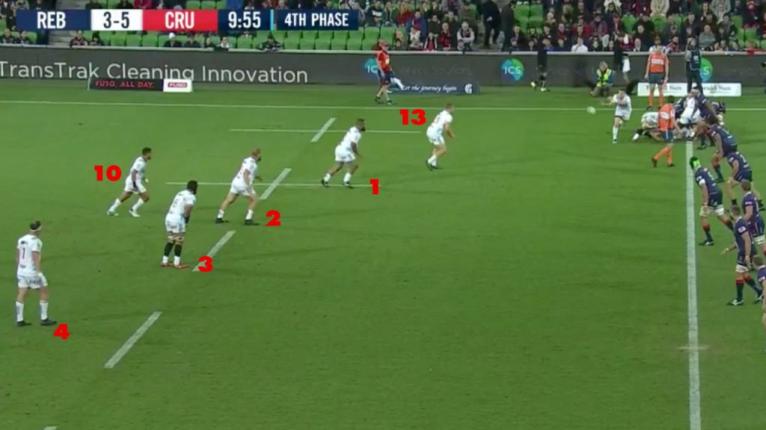
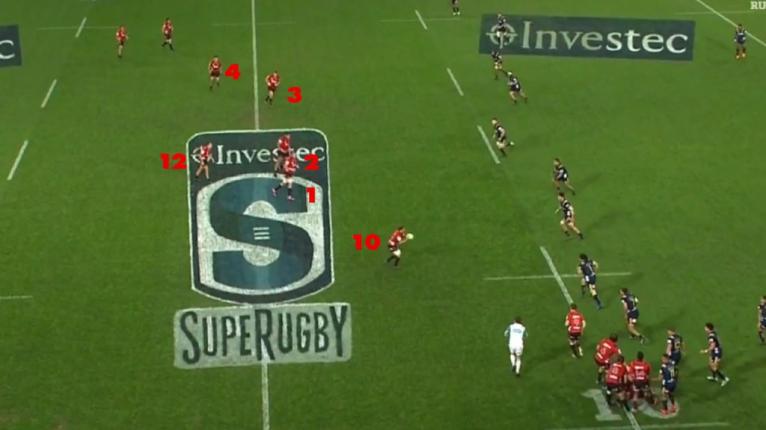
The roles of 10, 12, 13 are interchangeable and each player has the skills to perform it.
In both 2-4-2 situations, the Crusaders can use a swivel pass from the pod to release the ball to the edge all in one phase. The fourth middle forward becomes a decoy again and the screen pass is used to get the ball wide.
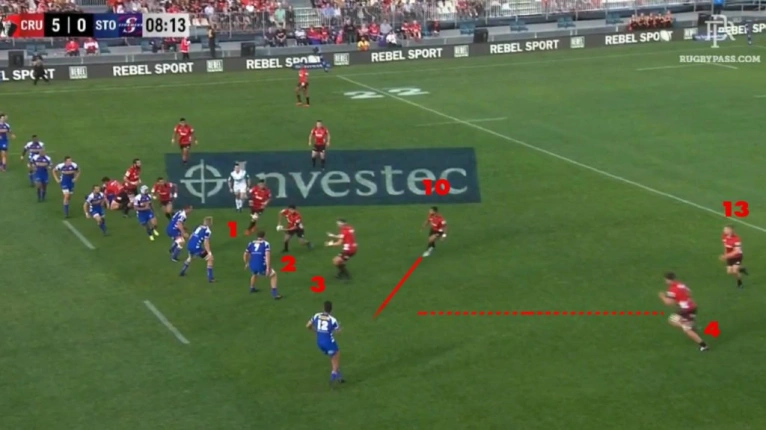

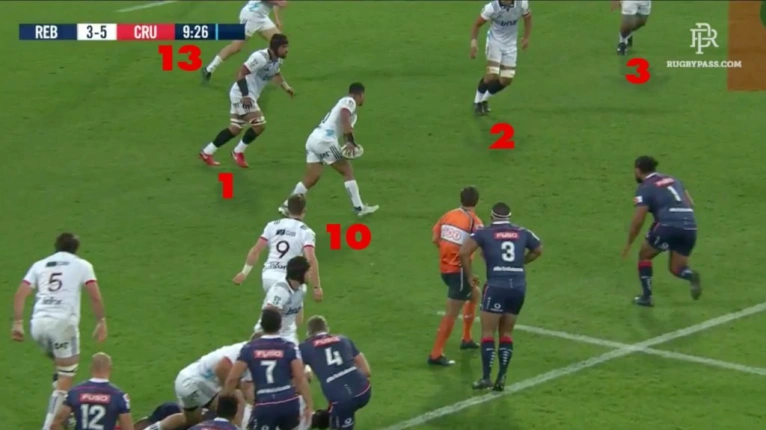
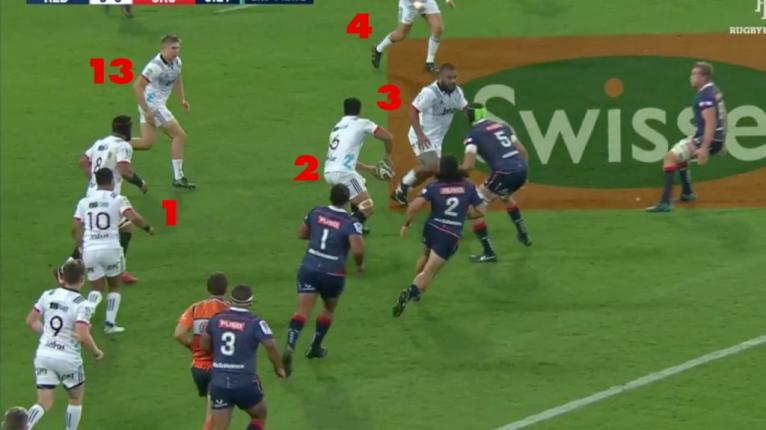
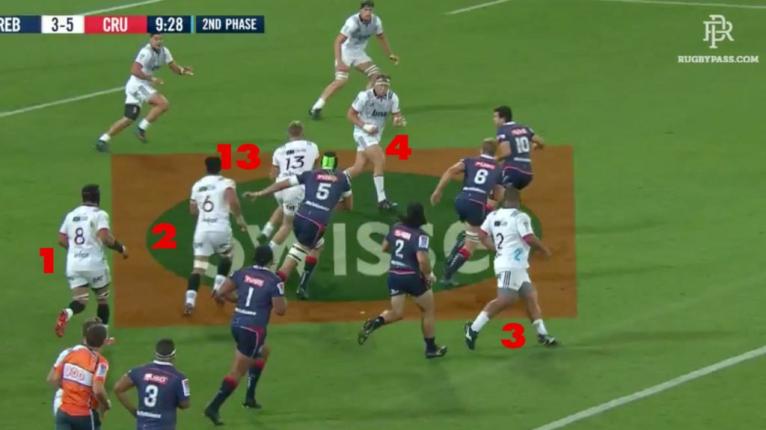
The fourth middle forward is the key to limiting the Crusaders 2-4-2 width. In almost all the instances he is a ‘dead’ runner, that is, not really an option to receive. He is the most isolated man in the Crusaders system, especially if the first pod takes a hit up. They don’t really want to give him the ball – the forwards from the first pod would still on the ground and the edge forwards are too far away to help.
Pressuring the backdoor option and forcing the Crusaders to use the fourth middle forward can stop the ball getting to the edges, and put them in a vulnerable situation with the surrounding backs required to secure the ruck, opening up the opportunity to win a turnover.
System Requirements
The Crusaders need certain players to fit their system, which means their requirements are a bit different than everyone else. This explains why players like Jack Goodhue are successful with them but he may not be if he was with the Blues. It’s not that he would be any worse of a player, just in the Blues structure he wouldn’t get the chance to flourish.
Goodhue is one of three primary first receiving options, giving him responsibilities he would never have with other teams at centre. Richie Mo’unga, Ryan Crotty and Jack Goodhue are interchangeable cogs that float around using their passing skills to keep the 2-4-2 machine moving.
Mo’unga takes the lion share of first receiving duties but he has the freedom to take the line on if he wants to, with Crotty and Goodhue available to take over if he is caught at the bottom of the ruck.
The edge forwards can again interchange, but runners like Matt Todd, Pete Samu, Codie Taylor will often find themselves flanked on the edge. The tight five generally provide the grunt work in the middle, with Number 8 Jordan Taufua being a primary ball carrier that can run the swivel pass. Locks Scott Barrett and Sam Whitelock can find themselves running in the wider channels at times, the pack works together to manage loads.
Ben Lam is grabbing all the headlines with a blistering 12 tries on the left edge, but Crusaders wings Manasa Mataele and George Bridge sit unassumingly in third and forth on the try-scoring list with eight and seven tries respectively. There is no better place to be a winger than the Crusaders.
This is a proven system that shows no signs of slowing. With a host of key New Zealand derbies at home in the closing stages of the regular season, don’t be surprised to see the Crusaders top the table once again.











































